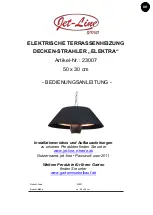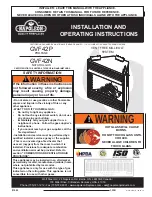
16
direct Vent appliances
Appliances installed in a Direct Vent configuration that derive all
air for combustion from the outdoor atmosphere through sealed
intake air piping are not factored in the total appliance input Btu/
hr calculations used to determine the size of openings providing
fresh air into confined spaces.
eXhaust fans
Where exhaust fans are installed, additional air shall be provided
to replace the exhausted air. When an exhaust fan is installed
in the same space with a water heater, sufficient openings to
provide fresh air must be provided that accommodate the
requirements for all appliances in the room and the exhaust fan.
undersized openings will cause air to be drawn into the room
through the water heater’s vent system causing poor combustion.
Sooting, serious damage to the water heater and the risk of fire
or explosion may result. It can also create a risk of asphyxiation.
louVers and grilles
The free areas of the fresh air openings in the instructions that
follow do not take in to account the presence of louvers, grilles or
screens in the openings.
The required size of openings for combustion, ventilation and
dilution air shall be based on the “net free area” of each opening.
Where the free area through a design of louver or grille or screen
is known, it shall be used in calculating the size of opening
required to provide the free area specified. Where the louver and
grille design and free area are not known, it shall be assumed
that wood louvers will have 25% free area and metal louvers and
grilles will have 75% free area. Non motorized louvers and grilles
shall be fixed in the open position.
unconfined space
An unconfined Space is one whose volume IS NOT leSS THAN
50 cubic feet per 1,000 Btu/hr (4.8 cubic meters per kW) of the
total input rating of all appliances installed in the space. rooms
communicating directly with the space, in which the appliances
are installed, through openings not furnished with doors, are
considered a part of the unconfined space.
makeup air requirements for the operation of exhaust fans,
kitchen ventilation systems, clothes dryers and fireplaces shall
also be considered in determining the adequacy of a space to
provide combustion, ventilation and dilution air.
unusually tight construction
In unconfined spaces in buildings, infiltration may be adequate
to provide air for combustion, ventilation and dilution of flue
gases. However, in buildings of unusually tight construction (for
example, weather stripping, heavily insulated, caulked, vapor
barrier, etc.) additional air must be provided using the methods
described in the Confined Space section that follows.
confined space
A Confined Space is one whose volume is less than 50 cubic
feet per 1,000 Btu/hr (4.8 cubic meters per kW) of the total input
rating of all appliances installed in the space.
Openings must be installed to provide fresh air for combustion,
ventilation and dilution in confined spaces. The required size for
the openings is dependent on the method used to provide fresh
air to the confined space and the total Btu/hr input rating of all
appliances installed in the space.
Venting installation
Venting
THe INSTruCTIONS IN THIS SeCTION ON VeNTING muST
Be FOllOWeD TO AVOID CHOkeD COmBuSTION Or
reCIrCulATION OF Flue GASeS. SuCH CONDITIONS
CAuSe SOOTING Or rISkS OF FIre AND ASPHyXIATION.
Heater must be protected from freezing downdrafts.
remove all soot or other obstructions from the chimney that will
retard a free draft.
Type B venting is recommended with these heaters.
This water heater must be vented in compliance with all local
codes, the current revision of the National Fuel Gas Code
(ANSI-Z223.1) and with the Category I Venting Tables.
If any part of the vent system is exposed to ambient temperatures
below 40°F (4.4°C) it must be insulated to prevent condensation.
• Do not connect the heater to a common vent or chimney with
solid fuel burning equipment. This practice is prohibited by
many local building codes as is the practice of venting gas
fired equipment to the duct work of ventilation systems.
• Where a separate vent connection is not available and the vent
pipe from the heater must be connected to a common vent with
an oil burning furnace, the vent pipe should enter the smaller
common vent or chimney at a point above the large vent pipe.
barometric draft control assembly
A double-acting barometric draft control assembly is provided
with each unit. The draft control assembly must be installed
without alteration. This assembly is factory adjusted for horizontal
application only and must be attached to the heater as shown in
Figure 11. The outlet of the draft control assembly may be rotated
to face in direction needed. The assembly must be fitted to the
jacket cover such that it is plumb and level to the ground. Fasten
the draft control assembly to the top cover using sheet metal
screws at three locations, or more, as required.
Dampers or other obstructions must not be installed between the
heater and the barometric draft control assembly.
Do not adjust settings on gate. Counterweight washers are factory
adjusted and should result in breeching pressure measurements
at the combustion test hole (Figure 11) within the range shown
in Table 9.
note:
A negative draft must be maintained in the vent piping.
When installed, the damper gate must pivot freely in the ring
guides. This gate will automatically adjust to regulate the chimney
draft imposed on the heater.
proper draft controller and
Vent pipe installation
figure 11.
Содержание GPG 81-140
Страница 25: ...25 LIGHTING OPERATION LABEL Figure 21 Label for Natural AND LP Gas Models ...
Страница 53: ...notes 53 ...
Страница 54: ...notes 54 ...
















































